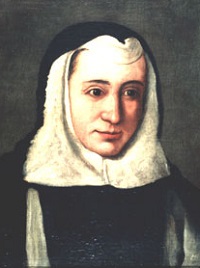
Sir Nicholas Bacon was Lord Keeper of the Great Seal during the first half of the reign of Queen Elizabeth I of England. He was the father of the philosopher and statesman Sir Francis Bacon.
Juan Ruiz, known as the Archpriest of Hita, was a medieval Castilian poet. He is best known for his ribald, earthy poem, Libro de buen amor.

Sor Juana Inés de la Cruz was a Mexican writer, philosopher, composer, poet of the Baroque period, and Hieronymite nun of New Spain (Mexico). Her outspoken opinions granted her lifelong names such as "The Tenth Muse" and "The Phoenix of Mexico", for she was a flame that rose from the ashes of "religious authoritarianism".

ABC is a Spanish national daily newspaper. It is the third largest general-interest newspaper in Spain, and the oldest newspaper still operating in Madrid.

Jorge Manrique was a major Castilian poet, whose main work, the Coplas a la muerte de su padre , is still read today. He was a supporter of the great queen, Isabel I of Castile, and actively participated on her side in the civil war that broke out against her half-brother, Enrique IV, when the latter attempted to make his daughter, Juana, crown princess. Jorge died in 1479 during an attempt to take the castle of Garcimuñoz, defended by the Marquis of Villena, after Isabel gained the crown.

The University of the Cloister of Sor Juana is a private university located in the former San Jerónimo Convent in the historic center of Mexico City. This convent is best known for having been the home of Sor Juana Inés de la Cruz for over twenty five years, she produced many of her writings here. After the convent was closed in the 19th century, the large complex was divided and was home to a number of institutions and businesses, including a large dance hall in the mid 20th century. In the 1970s, the government expropriated the complex, explored it and began the restoration process. In 1979, the current university was founded at this site and it is currently the benefactor and guardian of the complex. The institution offers bachelors, two masters and two certificates, mostly in the humanities. The institution also sponsors or co-sponsors a number of cultural and educational activities, mostly situated in the historic center of the city.

Teresa de Cartagena was a Spanish writer, mystic and nun who is considered to be the first Spanish female writer and mystic. She became deaf between 1453 and 1459. Her experience of deafness influenced her two known works Arboleda de los enfermos and Admiraçión operum Dey. The latter work represents what many critics consider as the first feminist tract written by a Spanish woman.

Blanco y Negro was a Spanish-language weekly art and literary magazine and later, the companion of the daily ABC. The magazine was published in Madrid, Spain.

Albert Guillem Hauf i Valls is a Majorcan philologist, literature historian and literary critic. He is a specialist in Catalan and Occitan medieval literature.

Josefa Amar y Borbón (1749–1833) was a Spanish writer, who belonged to a group of intellectuals that were bound together by a common concern for the decadent conditions of Spain and a desire to fix the situation through education. She is known as part of the first generation of Spanish feminists.

Ana de Castro Osório was a Portuguese feminist, active in the field of children's literature and political Republicanism.

María Rafaela de los Dolores y del Patrocinio, more commonly known as Sor Patrocinio, also known as "the nun of the wounds", was a Spanish nun of the Order of the Immaculate Conception. She was prominent in the Spanish social and political spheres in the second half of the 19th century through her influence over Queen Isabel II and the queen's husband, King Francisco de Asís de Borbón.
Ana Plácido (1831—1895) was a Portuguese novelist and author. Her best known work is the 1871 novel Herança de Lágrimas, and she is also noted for an autobiographical book Luz Coada por Ferros. She was married to the author Camilo Castelo Branco, with whom she earlier had an extra-marital affair while he was married.
The Liga das Mulheres Republicanas was a Portuguese feminist organisation founded in 1909 by Ana de Castro Osório and Adelaide Cabete. It split in 1912 after the refusal of the government to pass a law enabling women to vote. Cabete subsequently started the Conselho Nacional das Mulheres Portuguesas.
La ilustre fregona is a novella by Miguel de Cervantes, published in the collection Novelas ejemplares. It tells the story of two wealthy young men who fall in love with a kitchen maid in Toledo. The story contains mistaken identities, ironic comments and genre traits of the picaresque novel and pastoral romance.

The Vida de Jesucrist is a literary work by Francesc Eiximenis in Catalan written in Valencia possibly between 1399 and 1406, though the important scholar Albert Hauf dates it to 23 June 1403.. It was dedicated to Pere d'Artés, who was a kind of Chancellor of the Exchequer of the Crown of Aragon, whom Eiximenis had already dedicated the Llibre dels àngels.
"Man on Pink Corner" is a short story by Argentine writer and poet Jorge Luis Borges. It is the first of several stories he wrote concerning duels between knife-fighters, which Borges recognized as one of his archetypal themes. "The story is one I have been retelling, with small variations, ever since. It is the tale of the motiveless, or disinterested, duel—of courage for its own sake."

María Jacinta Xón Riquiac is a Maya Kʼicheʼ anthropologist and indigenous rights activist from Guatemala.













